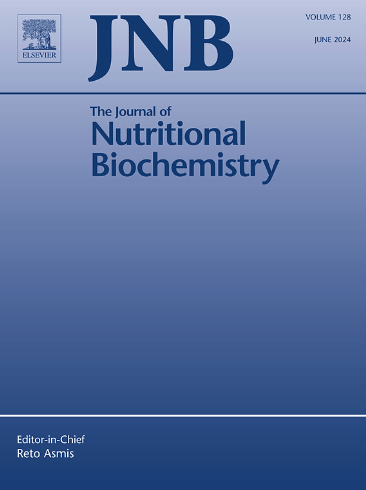The impact of pasture-fed versus total mixed ration derived whole milk powder (WMP) on circulating fatty acid concentrations and cardiometabolic health in healthy adults: Results from a randomized controlled crossover trial
IF 4.8
2区 医学
Q1 BIOCHEMISTRY & MOLECULAR BIOLOGY
引用次数: 0
Abstract
Whole milk powder (WMP) produced from pasture-fed dairy herds has been shown to have increased concentrations of unsaturated fatty acids (FA), including, but not limited to, ALA (C18:3 n-3) and oleic acid (C18:1 cis-9), compared to WMP derived from indoor herds consuming total mixed ration (TMR). Dairy products have been shown to have neutral or beneficial effects on cardiometabolic health, however, evidence on WMP in this area is lacking. Given the global market for WMP as a food ingredient, an investigation into the effect of TMR-fed vs pasture-fed WMP on human health is warranted. Therefore, the aim of this study was to test the effect of WMP derived from TMR-fed and pasture-fed herds on circulating FA concentrations and other markers of cardiometabolic health in adults. Healthy subjects were randomized to receive up to 200 g WMP/day as part of a 6-week crossover trial, with a 4-week washout period. WMP was produced from milks of TMR-fed and pasture-fed cows. WMPs were isocaloric and macro-nutrient matched. The primary outcome was difference in circulating FA between weeks 0 and 6. Changes in cholesterol concentrations, glycemic control, blood pressure and anthropometry were secondary outcomes. Dietary intake was also analyzed. A total of n 29 participants, 58.6% male, with a mean±SE age of 39.8±2.3 years and BMI of 26.12±1.39 kg/m2 completed the study protocol. No time × treatment interactions were observed for cholesterol concentrations, markers of glycemic control, blood pressure or anthropometry. There was no time × treatment interaction for classes of FA, however, the very long-chain saturated FA, lignoceric acid (C24:0), decreased in response to pasture-fed WMP consumption (−0.05±0.04 %TFA) with no change observed in response to the TMR WMP consumption (0.00±0.04 %TFA, P=.041), although this was not significant after Bonferroni correction for Type 2 error. Chronic, high-dose consumption of TMR and pasture-fed WMP had no effect on cardiometabolic health in healthy adults, despite different fatty acid composition. Comparison of foods with a proven dairy matrix effect, e.g., cheese made from TMR-fed and pasture-fed milks, may have more promising effects on human health. This trial was registered as ISRCTN10490434 (https://doi.org/10.1186/ISRCTN10490434).

放牧与全混合日粮衍生全脂奶粉(WMP)对健康成人循环脂肪酸浓度和心脏代谢健康的影响:一项随机对照交叉试验的结果
背景:与食用全混合日粮(TMR)的室内奶牛生产的全脂奶粉(WMP)相比,放牧奶牛生产的全脂奶粉(WMP)具有更高的不饱和脂肪酸(FA)浓度,包括但不限于ALA (C18:3 n-3)和油酸(C18:1顺式-9)。乳制品已被证明对心脏代谢健康具有中性或有益的影响,然而,在这一领域缺乏关于WMP的证据。鉴于WMP作为食品成分的全球市场,有必要调查TMR与牧场喂养的WMP对人类健康的影响。目的:测试来自TMR和放牧畜群的WMP对成人循环FA浓度和其他心脏代谢健康指标的影响。方法:健康受试者随机接受高达200g WMP/天,作为6周交叉试验的一部分,并有4周的洗脱期。WMP是由TMR奶牛和放牧奶牛的牛奶生产的。WMP是等热量和大量营养素匹配。主要结局是0-6周循环FA的差异,胆固醇浓度、血糖控制、血压、人体测量的变化是次要结局。饮食摄入量也被分析。结果:共有29名参与者完成了研究方案,其中男性58.6%,平均±SE年龄39.8±2.3岁,BMI 26.12±1.39 kg/m2。没有时间 × 观察到治疗对胆固醇浓度、血糖控制指标、血压或人体测量的相互作用。不同种类的FA没有 × 处理时间的相互作用,然而,长链饱和FA,木质酸(C24:0)在牧场喂养的WMP消耗(-0.05±0.04% TFA)的反应中下降,而在TMR WMP消耗(0.00±0.04% TFA, P=0.041)的反应中没有观察到变化,尽管在Bonferroni对2型错误进行校正后这并不显著。结论:尽管脂肪酸组成不同,但长期高剂量食用TMR和牧场饲养的WMP对健康成年人的心脏代谢健康没有影响。将已证实具有乳制品基质效应的食物(例如,由TMR制成的奶酪和牧场喂养的牛奶)进行比较,可能对人类健康产生更有希望的影响。该试验注册号为ISRCTN10490434 (https://doi.org/10.1186/ISRCTN10490434)。
本文章由计算机程序翻译,如有差异,请以英文原文为准。
求助全文
约1分钟内获得全文
求助全文
来源期刊

Journal of Nutritional Biochemistry
医学-生化与分子生物学
CiteScore
9.50
自引率
3.60%
发文量
237
审稿时长
68 days
期刊介绍:
Devoted to advancements in nutritional sciences, The Journal of Nutritional Biochemistry presents experimental nutrition research as it relates to: biochemistry, molecular biology, toxicology, or physiology.
Rigorous reviews by an international editorial board of distinguished scientists ensure publication of the most current and key research being conducted in nutrition at the cellular, animal and human level. In addition to its monthly features of critical reviews and research articles, The Journal of Nutritional Biochemistry also periodically publishes emerging issues, experimental methods, and other types of articles.
 求助内容:
求助内容: 应助结果提醒方式:
应助结果提醒方式:


